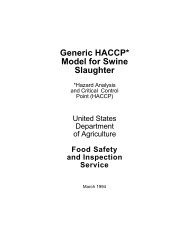Generic HACCP Model for Thermally Processed Commercial
Generic HACCP Model for Thermally Processed Commercial
Generic HACCP Model for Thermally Processed Commercial
You also want an ePaper? Increase the reach of your titles
YUMPU automatically turns print PDFs into web optimized ePapers that Google loves.
Product Spoilage in <strong>Thermally</strong> <strong>Processed</strong>, <strong>Commercial</strong>ly Sterile Food Products<br />
Ashton, D. H. 1981. Thermophilic organisms involved in food spoilage: thermophilic anaerobes<br />
not producing hydrogen sulfide. J. Food Prot. 44(2):146-148.<br />
This group of organisms, which are non-pathogenic, has been responsible <strong>for</strong> the type of<br />
spoilage known as 'hard swell'. It has been found in various canned products (especially<br />
vegetables), highly acid products such as fruit and tomatoes and in ingredients such as<br />
vegetables, sugar, dried milk, starch, flour, cereals, alimentary pastes and rendered meat.<br />
Characteristics are described of the type species, Clostridium thermosaccharolyticum.<br />
Recommended detection media, sporulation media and ingredient testing procedures are<br />
discussed. Survival of C. thermosacharolyticum spores in canned foods is of consequence<br />
only when cans are inadequately cooled and/or stored at greater than 35 degree C <strong>for</strong><br />
extended periods.<br />
Davidson, P. M., I. J. Pflug, and G. M. M. Smith. 1981. Microbiological analysis of food product<br />
in swelled cans of low-acid foods collected from supermarkets. J. Food Prot. 44(9):<br />
686-691.<br />
Swelled cans of low-acid food were collected from supermarkets over a 17-month period.<br />
Microorganisms were recovered from 47% of the 790 containers tested. Calculations<br />
suggested that approx. another 47% of the swelled cans were the result of microbial<br />
contamination, although no microorganisms were recovered, while 6% were physically<br />
induced (nonmicrobiological) swells. Food type appeared to influence the recovery of<br />
microorganisms. Types and incidences of organisms recovered were: 91.6% typical leaker<br />
spoilage microorganisms, 0.5% thermophiles, and 7.9% pure cultures of spore<strong>for</strong>ming<br />
organisms traditionally associated with underprocessing.<br />
Horwitz, M. A., J. S. Marr, M. H. Merson, V. R. Dowell, J. M. Ellis. 1975. A continuing<br />
common-source outbreak of botulism in a family. Lancet. 2(7940):861-3.<br />
In December, 1974, three cases of botulism occurred in a family; two were fatal. The first<br />
patient died after a 10-day illness without botulism being suspected. 4 days later, after a<br />
2-day illness, the second patient was diagnosed as having botulism after a<br />
cardiorespiratory arrest; she died 3 days later. In the third patient, the only symptom was<br />
dysphagia. Clostridium botulinum type B was found in stool specimens from all three<br />
patients. Home-canned (bottled) mushrooms, which were found to contain C. botulinum<br />
type B and its toxin, were believed to be responsible <strong>for</strong> the outbreak; mushrooms were<br />
found at necropsy in the gastrointestinal tracts of both patients who died. Heat treatment<br />
of the mushrooms during canning had been inadequate.<br />
Lake, D. E., R. R. Graves, R. S. Lesniewski, and J. E. Anderson. 1985. Post-processing spoilage<br />
67



